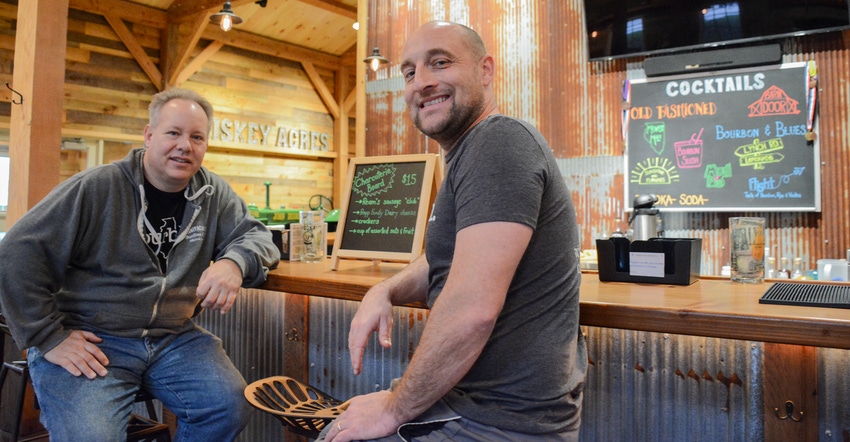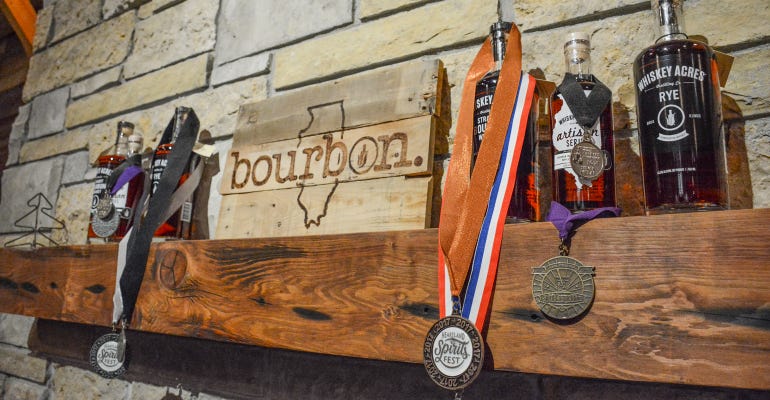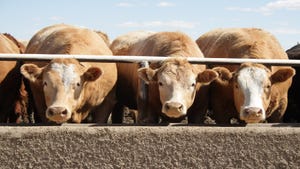
Farmers know grain bins can heat up and cool down quickly. That’s why they monitor the grain inside to avoid spoilage.
But when that grain is then distilled and poured into wood barrels for whiskey at the Walters’ farm near DeKalb, Ill., what is a temperamental storage environment inside grain bins becomes the ideal venue for aging. Quick changes in temperature cause the barrels’ char wood interiors to expand and contract across four years — giving the distilled spirit 50% of its flavor and 100% of its color.
Jamie Walter says the cross utility of grain bins is one of the many ways his grain farm has helped grow Whiskey Acres, his family’s on-farm distillery. Four years ago, he opened it with his father, Jim, who is a Prairie Farmer Master Farmer, and Nick Nagele of Wheaton, Ill. Now, they produce more than 100,000 bottles a year, which are sold in 500 locations across the state.
“We started the distillery to support the farm initially, but in terms of gross revenue, it’s turning out to be the other way around,” says Jamie Walter, who has farmed with his father for 20 years. “Very shortly, the farm will actually be the secondary business.”
Walter says each bottle of whiskey they produce contains about 3 pounds of corn. At retail prices, Whiskey Acres is achieving over $700 per bushel in gross revenue.
“We’re only achieving that with a minority of our grain production,” Walter says. “And, truth be told, we don't capture the retail dollar on every bottle we sell, as there’s a lot of wholesale business here that goes out to distributors. And of course, there’s lots of other costs in whiskey production, as well.”
Nevertheless, he says it’s “much better than being a strictly commodity farmer,” because each bottle he sells has a fixed price — like how specialty contracts lock in premiums for identity-preserved grain.
“We had a track record for growing identity-preserved grains before the distillery. In fact, for a time, we received a premium for non-GMO corn that was ultimately going to support beer in Japan,” Walter says. “That was one of the things that eventually led us to the alcohol industry.”
After receiving licenses from the state and federal government, Whiskey Acres aged its first vodka and whiskey lines in small barrels that sped up the aging process relative to normal-sized barrels. Eighty percent of the volume of liquor they’ve produced so far is still aging.
Preserving flavor
“There are differences in varieties of yellow dent corn that affect the flavor of the ultimate whiskey,” Walter says. “We’re one of the only distilleries in the world that is able to grow different grains, suss out those characteristics, what tastes better, and then identity-preserve it here on the farm and ultimately make whiskey out of it.”
He says the distillery mills all of their own grain used for their spirits production, including a 100% corn vodka. The only grain they don’t grow entirely on the farm is barley, which in whiskey production needs to be malted to help convert starch to sugar in corn, oats, rye and wheat.

SPIRIT: Whiskey Acres produces artisan whiskeys from heirloom corn and other irregular ingredients, as well as mainline whiskeys that are made from a blend of commercial grains.

Walter says Whiskey Acres sticks to three commercial varieties of corn for alcohol production in a given year. The mainline whiskey bottles generally combine spirits distilled from all three.
“In our artisan line, we have a three pack where we sell our main bourbon and then individual varieties of two other bourbons, where we use one variety of corn in each so that the customer can taste the difference,” Walter says.
Each year, he says, Whiskey Acres is trying out a dozen different commercial varieties and rotating two to three heirloom corn varieties. He says short of waiting for years, they can test the flavor of different grains by simply making a tea. They’ll save the best selections to further narrow down varieties for whiskey production.
“The tea is not something I would want to drink every day, but it helps us get some idea of flavor profiles. Later, as it comes off the still as clear alcohol, we can tell there’s some definite differences in characteristics,” Walter says.
One of the most noticeable changes in flavor comes from bad grain quality, Walter says. That’s why he sticks to commercial varieties for whiskey production, outside of heirlooms grown for the artisan line whiskeys.
“I’m not against organic. I’m not against non-GMO. But I am very pro grain quality,” Walter says. “On an organic farm, it’s difficult to control insects. Insects, when they nibble on the kernels of corn, they create entryways for pathogens. Those mycotoxins and pathogens, molds, mildews, etc., all can have a dramatic impact on the flavor of the grain, even if it’s just trace amounts.”
New visitors center
Whiskey Acres opened a new visitors center and bar at the end of last year to accommodate more guests on the farm. It’s open on weekends.
“Our first building was more of a tasting room. It’s actually a little less than 400 square feet,” Walter says. “This new building is close to 4,000 square feet, and the customers are already loving it. In short of two weeks since we opened it, our crowds are already up about 20%.”
He says the facility stands atop a well with water quality nearly identical to that of Bardstown, Ky., known as the Bourbon Capital of the World. To avoid taxing the well, Whiskey Acres reuses all its cooling water. This gives it a bigger energy draw than other distilleries, which led to installing solar panels that cover 100% of the energy needs of the distillery.
“With tours, we’re communicating our sustainability. Sustainability has always been a big part of what we do on this farm — frankly, what most farmers do. So we’re explaining why farmers choose to do things the way they do, too,” Walter concludes.
About the Author(s)
You May Also Like




